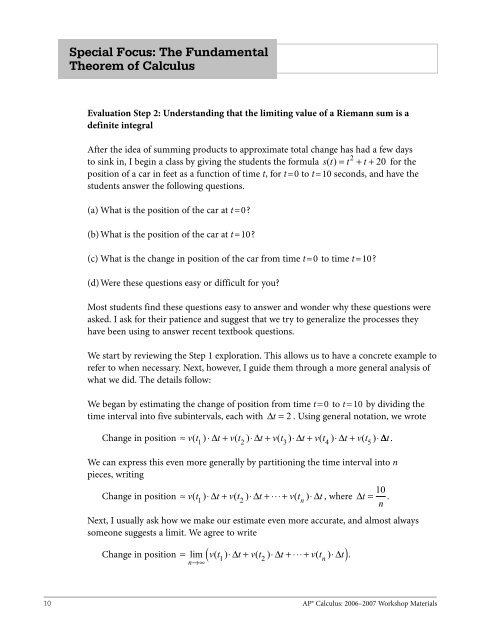AP Calculus
You also want an ePaper? Increase the reach of your titles
YUMPU automatically turns print PDFs into web optimized ePapers that Google loves.
Special Focus: The Fundamental<br />
Theorem of <strong>Calculus</strong><br />
Evaluation Step 2: Understanding that the limiting value of a Riemann sum is a<br />
definite integral<br />
After the idea of summing products to approximate total change has had a few days<br />
2<br />
to sink in, I begin a class by giving the students the formula s( t) = t + t + 20 for the<br />
position of a car in feet as a function of time t, for t=0 to t=10 seconds, and have the<br />
students answer the following questions.<br />
(a) What is the position of the car at t=0?<br />
(b) What is the position of the car at t=10?<br />
(c) What is the change in position of the car from time t=0 to time t=10?<br />
(d) Were these questions easy or difficult for you?<br />
Most students find these questions easy to answer and wonder why these questions were<br />
asked. I ask for their patience and suggest that we try to generalize the processes they<br />
have been using to answer recent textbook questions.<br />
We start by reviewing the Step 1 exploration. This allows us to have a concrete example to<br />
refer to when necessary. Next, however, I guide them through a more general analysis of<br />
what we did. The details follow:<br />
We began by estimating the change of position from time t=0 to t=10 by dividing the<br />
time interval into five subintervals, each with ∆t = 2 . Using general notation, we wrote<br />
Change in position ≈ v( t ) ⋅ ∆t + v( t ) ⋅ ∆t + v( t ) ⋅ ∆t + v( t ) ⋅ ∆t + v( t ) ⋅ ∆t .<br />
1 2 3 4 5<br />
We can express this even more generally by partitioning the time interval into n<br />
pieces, writing<br />
Change in position ≈ v( t1 ) ⋅ ∆t + v( t2<br />
) ⋅ ∆t + ⋅⋅⋅ + v( tn<br />
) ⋅ ∆ t , where ∆t = 10 .<br />
n<br />
Next, I usually ask how we make our estimate even more accurate, and almost always<br />
someone suggests a limit. We agree to write<br />
Change in position = lim v ( t ) ⋅ ∆t + v ( t ) ⋅ ∆t + ⋅⋅⋅ + v ( t ) ⋅ ∆ t .<br />
n<br />
( )<br />
1 2<br />
n<br />
→∞<br />
10<br />
<strong>AP</strong>® <strong>Calculus</strong>: 2006–2007 Workshop Materials


